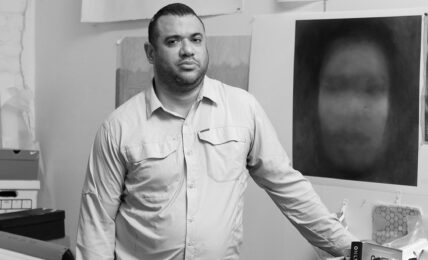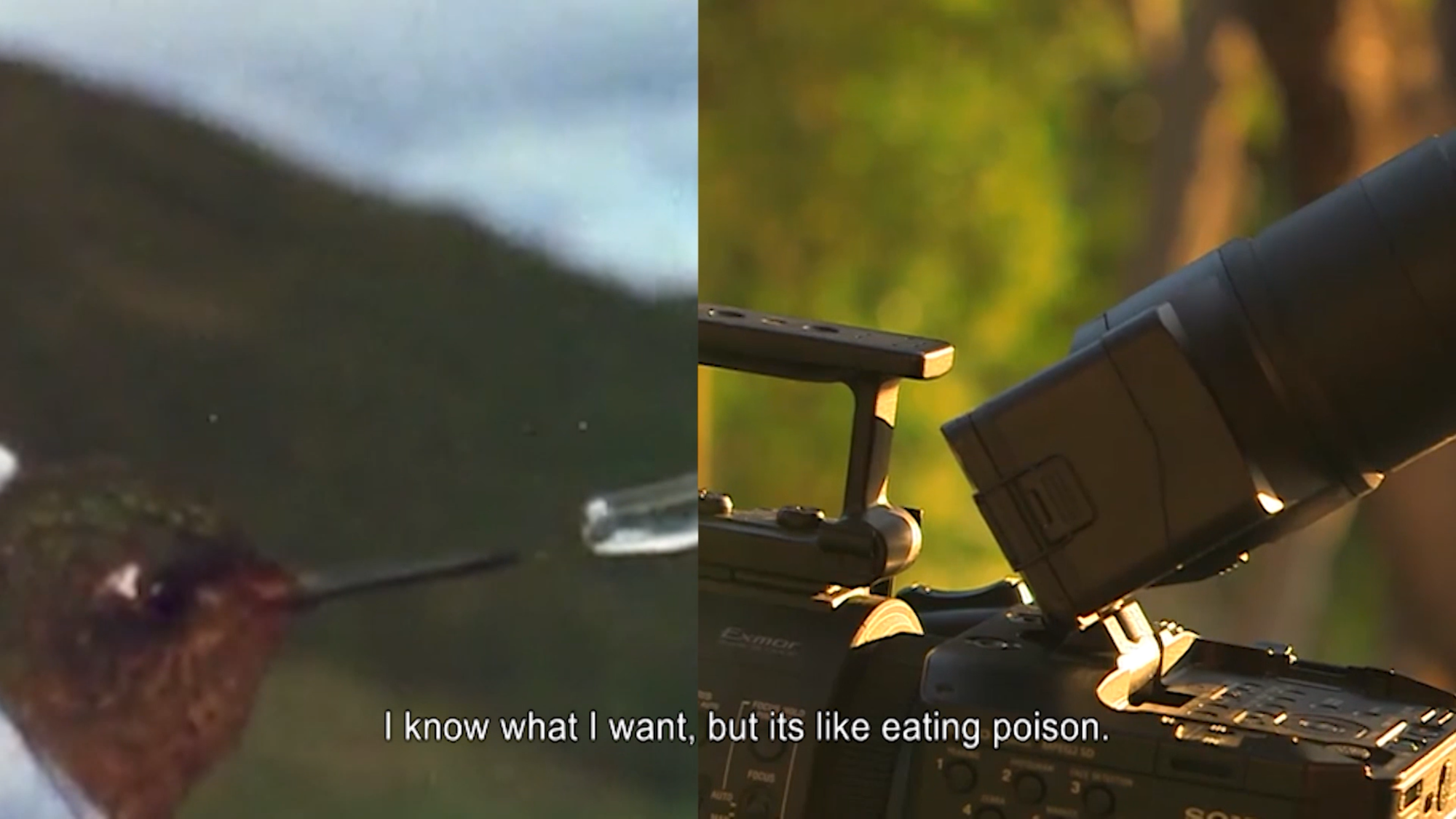Emily Sasmor’s work STRANGERS COWBOYS was published in Issue 11 of Digital America. Sasmor talked with Digital America about her overarching series HOTLINE FOR THE LOST, how she approaches themes of violence, pop culture, and the real vs. the simulated in her work.
:::
DigA: In STRANGERS COWBOYS, there is a constant back and forth, a kind of peering inward and outward when we experience the piece. Can you talk about the different levels of reality present in HOTLINE FOR THE LOST?
ES: HOTLINE FOR THE LOST constantly fluctuates between being real and not, it’s always somewhere in the middle. It’s a building up of simulations (by which I mean physical, emotional, and digital systems that use thinly-veiled manipulations to control experiences) to create a space based on skins/surfaces of places, intimacies, experiences, and people. The vast sum of these skins/surfaces make the package’s world have real qualities, but underneath each skin/surface there isn’t much beyond violence and trauma. The thing about simulations is they’re both real and not. Simulations lie to you, but the effects they produce are very real.
I think maybe the clearest example of how I try to make these skins/surfaces work is in the COWBOY characters. All the COWBOY characters are female-identifying*, even though within the USA ‘cowboys’ are generally perceived as white, cisgender, straight, Christian males who expel toxic masculinity — the ‘ideal’ body type within white supremacist, patriarchal, heteronormative societies. Everyone who isn’t ‘ideal’ is expected to try to achieve the state of a ‘cowboy.’ Emotional and physical violence is placed on those who are incapable of taking on that form. So the COWBOY characters, who in this case are female-identifying, are placed under the tension of an assumption that they should/want to take on the mannerisms of a ‘cowboy.’
But all the skins/surfaces of things in the project are put on display to get the audience to decide what’s real or not for them. I’ve tried to structure the project as an unreliable simulation where its seams are exposed. HOTLINE FOR THE LOST is generally creepy, unnecessarily complex, and uncomfortable as method of indicating the edges of the simulation.
DigA: There is an undeniable and evocative tension in your videos that seems to be the result of a system of underlying violence. How did you decide to represent this in HOTLINE FOR THE LOST?
ES: I have a lot of issues with the ways people generally present physical violence. In the work I make I don’t see any reason for literally showing physical acts of violence. I think that in many ways that’s exploitative, and can be harmful to the audience. There are definitely some exceptions to that rule, but they’re few and far between. One to one depictions of physical violence have made me viscerally upset and I don’t want to do that to someone else.
When I’m presenting physical violence I try to do it in a (hopefully) more caring way. Instead of just showing it, I normally have insinuations — sounds, text, and imagery that indicate physical violence is occuring out of view. The audience can tell/feel something is happening, but they can’t see it. I think doing it this way does the work that a one to one showing of physical violence is supposed to do, but in a way that’s less harmful. There’s probably some better way of going about that, but that’s the solution I’ve come up with for the time being.
I handle emotional violence very differently. Emotional violence is this constant tension based in little details. If you’re not used to it, or you’re in a position where you don’t have to deal with it all the time, it can be really hard to notice. So in HOTLINE FOR THE LOST, emotional violence is meant to always be evident. The little details in the sounds, visuals, and text try to build the tension of that type of violence. I do try to make a few momentary reprieves from it in jokes. But generally, I’m the only one who thinks those are funny/notices them.
DigA: Was there any intentionality in designing this amalgamated and interactive performance / video piece as an opera? That is to say, why specifically opera?
ES: For me, calling HOTLINE FOR THE LOST a morality opera is 90% serious and 10% a joke. The project is really structured like a morality play. These plays have a main character who embodies some idea of the whole of humanity (or some subset of it) and meets a series of personifications. The personifications that appear attempt to make the main character lead a godly life or an evil one. HOTLINE FOR THE LOST emulates that, though it has two main differences. All the characters in HOTLINE FOR THE LOST are meant to be personifications, there’s no main character. The package is also not trying to lead the characters to be good or bad. It tries to lead them, but ends up really making them more lost.
The project also takes a lot of its structure from Robert Ashley’s TV opera Perfect Lives. That project is generally described as “an opera made for television.” During its TV broadcasts it presents a complex, non-linear narrative. The music and language (both vocal and written) are the momentum of that project. For me, the imagery is important but it’s more of a structure for the text and sound to exist within. I feel like HOTLINE FOR THE LOST emulates that model.
So even though the project is a mixture of a morality play and an opera, I felt ‘opera’ was the more appropriate word because the driving force of the project is its musicality. To say it follows any specific structures of an opera would be inaccurate — I co-opted the word for my own purposes.
DigA: You use several well known songs as part of the soundtrack of your opera. How are they meant to impact viewers?
ES: Popular music is generally a mainstay of my work. I see it as a language within itself. Each song presents an encapsulated emotion, or a word. When you put them together you can construct new sentences and narratives. The narrative will slightly alter for each viewer, as each song is experienced differently. The stringing together of different songs begins to emulate the structures of pop music. Its systems manipulate you, while you simultaneously manipulate it with your point of view. I also heavily alter the songs in an effort to curate each song’s emotion.
That type of idea is ripped from musical genres like Vaporwave and Witch House. They take popular songs and adapt them to create new narratives. Both do it in ways that I find ethically concerning, Witch House more so than Vaporwave. There is often the appearance of little care in how the original songs are used.
I use the logic of Vaporwave and Witch House, but carefully decide which songs to use. These songs have histories and I don’t want to use them in harmful ways. Looking back at the project now, I’ve noticed some songs that I probably shouldn’t have used in the way I did. It’s a process of trying to figure out how to ethically appropriate.
DigA: Can you talk about your decision to include conceptual sound in Avocado Grove?
ES: I actually wrote AVOCADO GROVE at two different points. The first version of it was the very first thing I made for this project. I originally wrote the play when I was in this more naive/privileged headspace. I wasn’t in a place in my life where I knew how to really deal with the content I was trying to talk about. I got really frustrated with the first version, put it to the side for a while, and directed my focus at STRANGERS COWBOYS.
About a year later I started editing it again in a very melancholic headspace. I kept the narrative/concept, while adding many of the details. This included the conceptual sounds. These sounds were meant to make the text only experienceable through reading. Sounds described as not having any material are an example of this. The conceptual sounds that play the biggest roles are the singing and ‘interruptions.’ I feel like that text is 90% characters singing popular songs (with altered versions of their lyrics) to each other. It’s meant as more direct version of how people manipulate the music they listen to. The ‘interruptions’ are spreads which appear between the scenes of AVOCADO GROVE. They’re attempts by the book to stop you from reaching the end.
I think that writing AVOCADO GROVE at two different points was important in producing a mixture of naivety and melancholy. The characters in the text were always really naive.They end up accidentally hurting themselves and the people around them because of their naivety. But the melancholy that got added later on, through things like the conceptual sounds, is this warning to the reader that something’s off.
DigA: There’s a physicality, anticipation, and care that went into constructing the experience of HOTLINE FOR THE LOST. Can you talk to us about your process to creating a truly multi-media piece?
ES: HOTLINE FOR THE LOST was made in this very fluid way over a two year period. It started with me buying a collection of Louis L’Amour cassette tape audiobooks off eBay for a different (trashed) project. L’Amour was known for writing these silly short morality tales that took place in the old west. I thought the stories were strange, largely because I think it’s really ridiculous to base a morality tale off of the old west (an era totally lacking ethics). All L’Amour’s stories are very questionable ethically, but pursue romanticizing the morals of white supremacist, patriarchal, heteronormative societies. I became interested in trying to make ‘morality’ stories — which later became the acts of the opera — based in the old west that were more accurate to the period’s reality.
All the acts of the project are built from 75% appropriated materials (which I restructure and take from a diverse set of places) and 25% original materials. When it came to constructing each act I tried to use the materials that best fit each, combining small objects, videos, and texts. For me the small objects are quick jokes, and the videos and text are the spaces where the project gets its complexities. But generally I try to use flexible materials because my work is very stream of consciousness. Everything has a reason for being there, but I figure out/make up the logic for its purpose as I go. I normally only have a basic outline beforehand. Originally most of the acts were separate projects, but I realized that together they built a larger, stronger narrative.
At the same time I was starting to really lean back from making artwork for gallery/screening/performance spaces. Those spaces are very controlled, there’s such a specific way your body is supposed to exist within them. For me I want the audience to have as much control over their experience as possible. The most obvious way I could have given that control would have been to present it on the internet, but I felt like that wasn’t the best. The internet is all about speed, and my projects are these very slow, dense things. As I was trying to come up with another mode of presentation, I started looking into telephone and mail art projects. I realized those methods worked at the slow speed I needed. The idea to make a hotline where you could order a package came from combining those. Basically after I figured out the format, I started building off of it to make the six act morality opera that it is now.
*Changed from “female bodied” as requested by the artist 10/30/2018.



